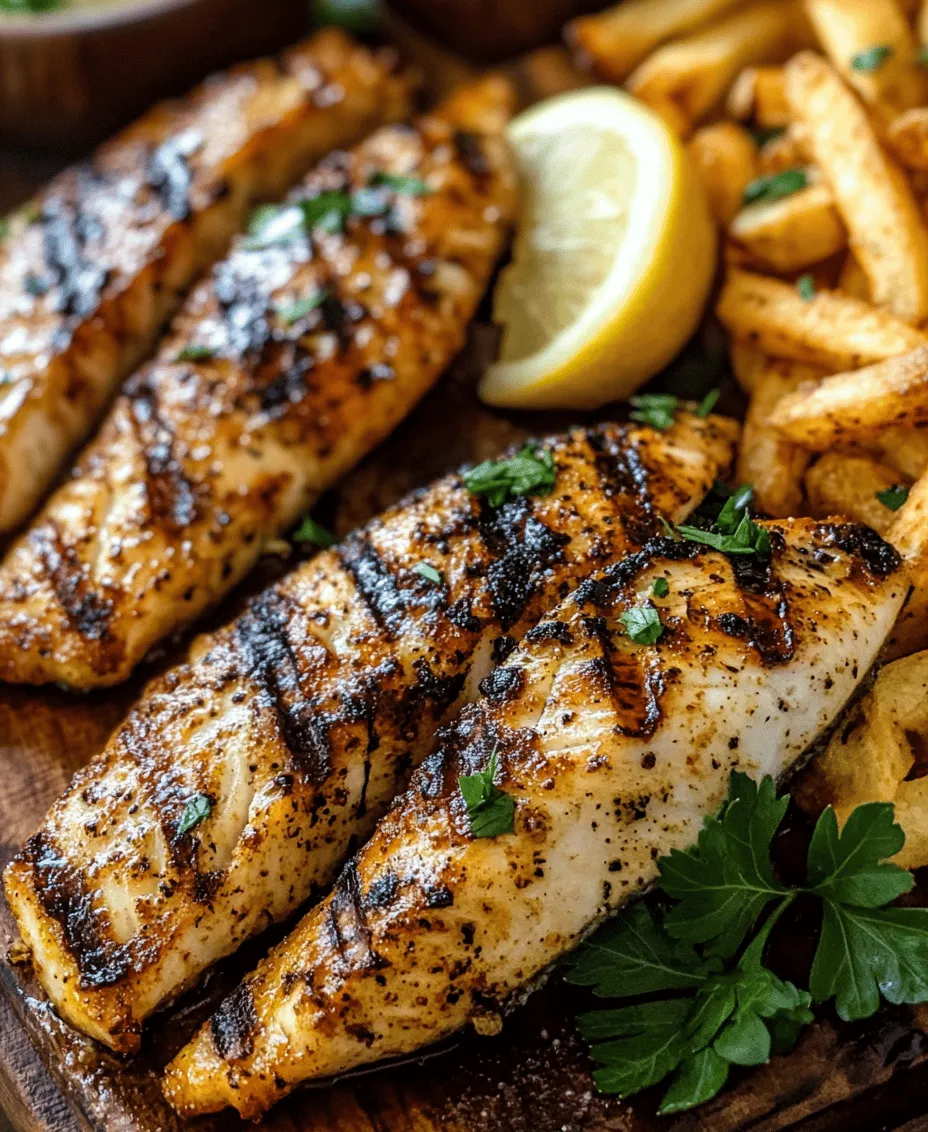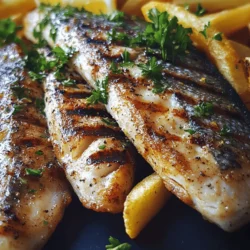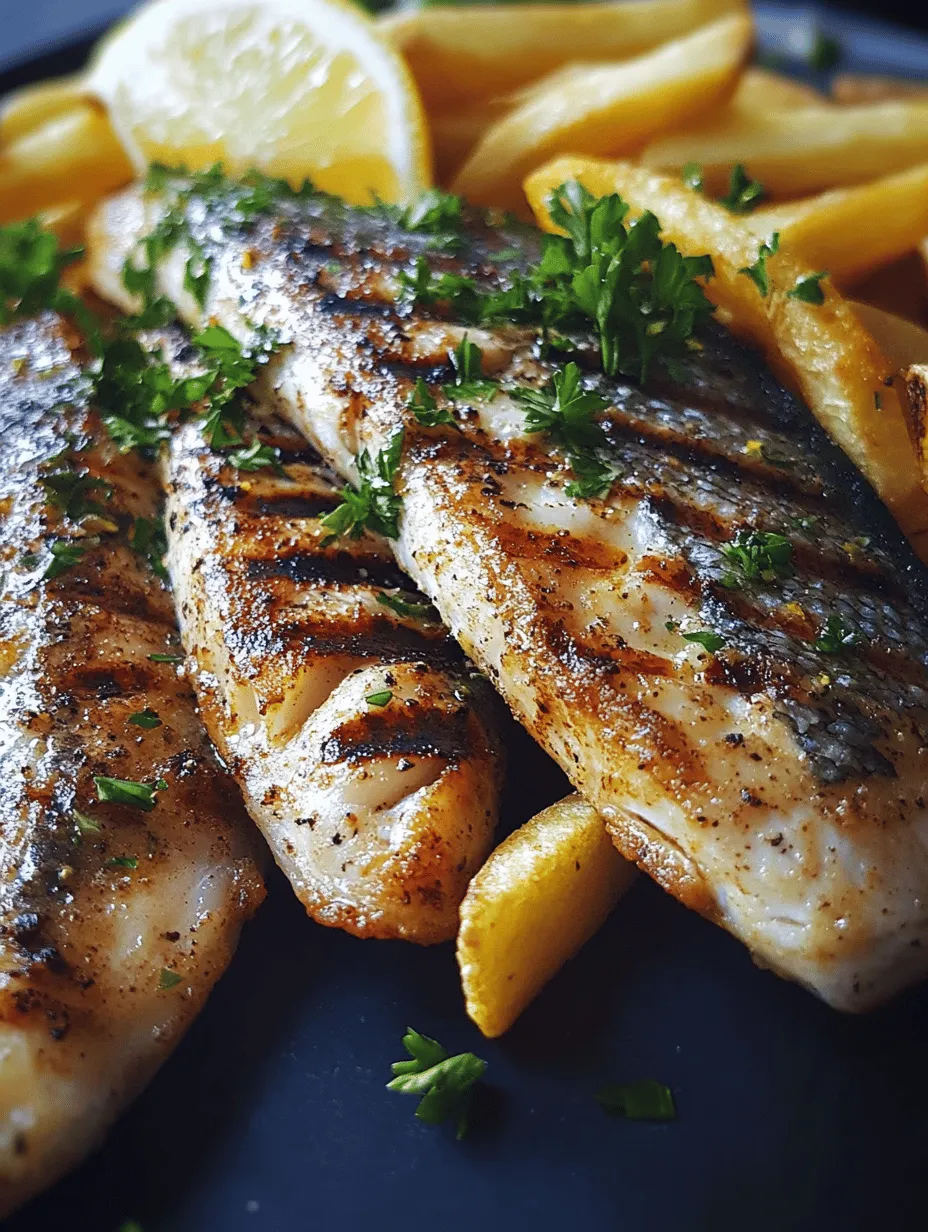Introduction
Grilled fish with crispy fries is a timeless dish that beautifully combines the delicate, flaky texture of perfectly cooked fish with the satisfying crunch of golden fries. Whether you are enjoying a casual family dinner or hosting a summer barbecue, this dish brings a sense of joy and comfort that transcends culinary boundaries. The appeal of grilled fish lies not only in its succulent flavor but also in the healthy aspect of the dish, making it a favorite among health-conscious individuals and seafood lovers alike.
The balance of flavors in this dish is truly remarkable. The smoky char from the grill enhances the natural taste of the fish, while the crispy fries serve as a delightful counterpoint, offering a satisfying crunch with each bite. The interplay between the tender fish and the crispy fries creates a harmonious dining experience that is both simple and sophisticated.
Using fresh ingredients is paramount in achieving the best flavor and texture in this dish. The quality of the fish and the choice of potatoes play crucial roles in elevating the overall experience. Additionally, mastering specific cooking techniques can make all the difference in transforming a good meal into a great one. In this article, we will delve into the ingredients, marinade, and the art of preparing perfect fries, ensuring that you can recreate this delicious dish with confidence.
Understanding the Ingredients
When it comes to grilling fish, not all varieties are created equal. The choice of fish can significantly impact the flavor and texture of the final dish. Here are some of the most popular fish varieties that are ideal for grilling:
Cod
Cod is a versatile fish known for its mild flavor and flaky texture. Its firm flesh holds up well on the grill, making it an excellent choice for those who are new to cooking fish. Cod can absorb marinades beautifully, enhancing its natural taste without overpowering it.
Tilapia
Tilapia is another popular choice for grilling, thanks to its mild flavor and affordability. This fish has a slightly firmer texture than cod and can withstand high cooking temperatures without falling apart. Tilapia is a great option for those looking to create a light, healthy meal.
Grouper
Grouper is a favorite among seafood enthusiasts, known for its sweet, mild flavor and meaty texture. This fish is particularly well-suited for grilling, as it can develop a lovely char while remaining moist and tender on the inside. Grouper pairs wonderfully with a variety of marinades and seasonings, making it a versatile option.
Benefits of Fresh Herbs and Spices
In addition to selecting the right type of fish, incorporating fresh herbs and spices is essential for elevating the flavors of your grilled fish. Fresh herbs like parsley, cilantro, and dill can add brightness and complexity to the dish, while spices such as garlic, paprika, and oregano contribute depth and warmth.
– Garlic: Adds a robust flavor and aroma that enhances the overall taste of the fish. It works particularly well when combined with oil in marinades.
– Paprika: Offers a subtle smokiness and rich color, making it a perfect addition to grilled fish. Smoked paprika can add an extra layer of flavor that complements the char from grilling.
– Oregano: This herb brings a Mediterranean flair and pairs beautifully with fish. It adds an earthy, slightly sweet flavor that rounds out the dish.
Choosing the Right Potatoes for Fries
The type of potatoes you use for your fries can make or break this dish. For the crispiest fries, russet potatoes are the best choice. They are high in starch and low in moisture, which allows them to achieve that perfect crispy exterior while remaining fluffy on the inside.
Characteristics of Russet Potatoes:
– High Starch Content: This is essential for achieving a crispy texture. The starches gelatinize during frying, creating a crunchy coating.
– Low Moisture: A lower moisture content means that the fries can become crispy without becoming soggy.
– Shape: Russet potatoes are typically long and cylindrical, making them easy to cut into uniform fry shapes.
Marinade Magic
Marinating the fish is a crucial step in preparing grilled fish with crispy fries. A well-crafted marinade not only infuses the fish with flavor but also tenderizes it, resulting in a moist and delicious end product.
Importance of Marinating Fish
The process of marinating allows flavors to penetrate the fish, enhancing its taste and creating a more enjoyable eating experience. The acid in the marinade helps to break down proteins, resulting in a tender texture. Additionally, marinating can help to add moisture to the fish, preventing it from drying out on the grill.
Step-by-Step Guide to Preparing the Marinade
Creating a marinade is simple and can be tailored to your taste preferences. Here’s a basic recipe to get you started:
Ingredients for Marinade:
– 1/4 cup olive oil
– 2 tablespoons lemon juice (freshly squeezed)
– 2 cloves garlic, minced
– 1 teaspoon smoked paprika
– 1 teaspoon dried oregano
– Salt and pepper to taste
Instructions:
1. Combine Ingredients: In a bowl, whisk together the olive oil, lemon juice, minced garlic, smoked paprika, dried oregano, salt, and pepper until well combined.
2. Marinate the Fish: Place your chosen fish in a shallow dish or a resealable plastic bag. Pour the marinade over the fish, ensuring it is evenly coated. Seal the bag or cover the dish with plastic wrap.
3. Refrigerate: Allow the fish to marinate in the refrigerator for at least 30 minutes and up to 2 hours. Avoid marinating for too long, as the acid in the lemon juice can begin to “cook” the fish, resulting in a mushy texture.
Best Practices for Marinating Fish
– Use Fresh Ingredients: Fresh herbs, spices, and citrus will yield the best flavor. Avoid using dried herbs as the primary ingredient, as they can result in a less vibrant taste.
– Don’t Overdo It: Fish is delicate, so marinating for too long can lead to a mushy consistency. Stick to the recommended time to achieve the best results.
– Keep It Cool: Always marinate fish in the refrigerator to prevent bacterial growth. Avoid leaving fish to marinate at room temperature.
Perfecting the Fries
Crispy fries are essential for complementing your grilled fish, and achieving that perfect texture requires a bit of technique. The process begins with cutting the potatoes and soaking them to remove excess starch.
The Science Behind Soaking Fries
Soaking fries in water before frying is crucial for achieving maximum crispiness. This process removes excess starch from the surface of the potatoes, which can create a gummy texture when fried. By soaking the fries, you allow them to develop a beautiful, crispy exterior.
Cutting and Soaking Fries
1. Prepare the Potatoes: Start by peeling the russet potatoes, if desired. Place them on a cutting board and cut them into uniform sticks, about 1/4 to 1/2 inch thick. Uniformity is key to ensuring that the fries cook evenly.
2. Soak the Fries: Place the cut fries in a bowl of cold water and let them soak for at least 30 minutes. For best results, soak them for up to 2 hours. This soaking process not only removes excess starch but also helps to keep the fries crispier for longer.
3. Drain and Dry: After soaking, drain the fries and pat them dry with a clean kitchen towel or paper towels. Removing excess moisture is essential for achieving that desired crispy texture.
Techniques for Frying Potatoes
1. Oil Temperature: For the crispiest fries, it’s crucial to fry them at the right temperature. Heat oil in a deep fryer or a large, heavy pot to 350°F (175°C). Use a thermometer to ensure the temperature remains consistent throughout the frying process.
2. Batch Frying: Fry the potatoes in small batches to avoid overcrowding the pot. Overcrowding can cause the oil temperature to drop, resulting in soggy fries. Fry each batch for about 4-5 minutes, or until they are golden brown and crispy.
3. Draining Excess Oil: Once the fries are done frying, use a slotted spoon to remove them from the oil and place them on a plate lined with paper towels to absorb excess oil. Season with salt while they are still hot for maximum flavor.
By following these steps, you can create perfectly grilled fish paired with deliciously crispy fries. Each component of this dish complements the other, resulting in a satisfying meal that is sure to please everyone at the table. Stay tuned for the next part of the article, where we will dive deeper into serving suggestions and additional tips for making this dish an unforgettable experience.

Grilling the Fish
Preparing the Grill: Tips for Success
To achieve the best flavor and texture when grilling fish, it’s essential to prepare your grill properly. Begin by cleaning the grill grates thoroughly with a grill brush to remove any leftover residue from previous cookings. This not only helps prevent sticking but also ensures a clean taste. Preheat the grill for about 10 to 15 minutes on medium-high heat before you start cooking. Oil the grates lightly with a paper towel dipped in vegetable oil or use a non-stick spray to create a barrier between the fish and the grates, further reducing the risk of sticking.
How to Achieve the Ideal Grilling Temperature
The ideal grilling temperature for fish typically ranges from 375°F to 450°F (190°C to 230°C). To test your grill’s temperature, you can use an instant-read thermometer or perform the hand test: hold your hand about 6 inches above the grill grates and count how long you can keep it there. If you can hold it for 2-4 seconds, the grill is hot; 5-7 seconds indicates medium heat; and if you can hold it for longer, it’s time to increase the heat.
Step-by-Step Grilling Process
Once the grill is preheated, it’s time to grill your fish. Start by placing your seasoned fish fillets on the grill grates, keeping them on the hot side of the grill. Here’s a simple step-by-step process:
1. Place the Fish: Lay the fish skin-side down on the grill grates.
2. Cover the Grill: Close the grill lid to help the fish cook evenly.
3. Cook Time: Grill the fish for approximately 3-5 minutes per side, depending on the thickness. A general rule is to cook the fish for about 8-10 minutes per inch of thickness.
4. Flip Carefully: Use a spatula to gently flip the fish. If it sticks to the grill, give it a little more time to cook; it will release when ready.
5. Check for Doneness: The fish is done when it flakes easily with a fork and has an internal temperature of 145°F (63°C).
Timing and Indicators for Perfectly Grilled Fish
Timing is crucial for grilling fish. You can tell the fish is nearly done when it begins to turn opaque and the flesh starts to flake. Use a fork to gently test the doneness by twisting it slightly; if it flakes away easily, it’s ready to be taken off the grill. Remember to remove the fish from the grill immediately to prevent overcooking.
Common Grilling Mistakes to Avoid
Grilling fish does come with its pitfalls. Here are some common mistakes to avoid:
– Overcrowding the Grill: Avoid placing too many fillets on the grill at once. This can lower the temperature and lead to uneven cooking.
– Turning Too Often: Resist the urge to flip the fish frequently. Let it cook on one side before turning to get those beautiful grill marks and caramelization.
– Not Preheating the Grill: Skipping the preheating process can lead to sticking and uneven cooking.
– Not Using a Thermometer: Relying solely on visual cues can sometimes result in undercooked or overcooked fish. A thermometer helps ensure perfect doneness.
Presentation and Serving Suggestions
Tips for Plating Grilled Fish and Fries Elegantly
Presentation plays a significant role in the dining experience. For an elegant presentation, start with a clean white plate that allows the colors of the food to pop. Place the grilled fish fillet at an angle on one side of the plate and arrange crispy fries beside it. You can also stack the fries for added height and visual interest.
Importance of Garnishing with Parsley and Lemon
Garnishing is essential for enhancing both the look and flavor of your dish. A sprinkle of fresh parsley adds a touch of color and freshness, while lemon wedges not only look appealing but also invite diners to squeeze fresh juice over the fish, brightening the flavors. Consider adding a few capers or cherry tomatoes for an additional pop of color and flavor.
Pairing Options to Enhance the Meal
To elevate your grilled fish and fries, consider pairing them with complementary sides. A simple side salad with a light vinaigrette can add freshness to the meal. Alternatively, coleslaw provides a crunchy texture that balances the dish’s richness.
Suggested Sides or Sauces that Complement the Dish
Sauces can dramatically enhance your grilled fish and fries. Tartar sauce, a classic companion, offers a creamy, tangy contrast. For a lighter option, consider a homemade yogurt sauce mixed with dill and lemon. A spicy aioli could also be a great addition for those who enjoy a kick.
Ideas for Creating a Complete Meal Experience
To create a complete meal experience, serve your grilled fish with a variety of textures and flavors. Incorporate grilled vegetables like asparagus or bell peppers, which add color and nutrients. For a heartier meal, consider a grain-based salad, such as quinoa or couscous, mixed with fresh herbs and a citrus dressing.
Beverage Pairings and Additional Sides
When it comes to beverages, crisp white wines like Sauvignon Blanc or a light-bodied rosé pair beautifully with grilled fish. For non-alcoholic options, consider sparkling water with a slice of lemon or a refreshing iced tea.
Nutritional Benefits of the Dish
Overview of the Health Benefits of Grilled Fish
Grilled fish is not only delicious but also a highly nutritious choice. Fish is an excellent source of lean protein, essential vitamins, and minerals. Opting for grilling over frying helps retain these nutrients without added fats, making it a healthier cooking method.
Omega-3 Fatty Acids and Lean Protein Sources
One of the standout features of fish is its high omega-3 fatty acid content, known for supporting heart health and reducing inflammation. Fish like salmon, mackerel, and sardines are particularly rich in these beneficial fats. Additionally, grilled fish is a fantastic source of lean protein, which is vital for muscle repair and overall health.
Nutritional Profile of Homemade Fries Versus Fast Food Options
When it comes to fries, making them at home allows you to control the ingredients and cooking methods. Homemade fries can be made with fresh potatoes and minimal oil, providing a healthier alternative to fast food options that are often loaded with unhealthy fats and preservatives. Baking or air-frying your fries can significantly reduce calorie content while still delivering that satisfying crunch.
Benefits of Controlling Ingredients and Cooking Methods
Preparing your dish at home gives you complete control over what goes into your meal. You can choose high-quality fish, fresh herbs, and healthy oils, ensuring a meal that is not only tasty but also nutritious. This control can lead to lower sodium levels and fewer unhealthy additives, making your grilled fish and fries a wholesome choice.
Cultural Significance of Fish and Chips
A Brief History of Grilled Fish and Fries in Global Cuisines
The combination of fish and chips is a culinary classic that has roots in various cultures. In the United Kingdom, it became popular in the 19th century as a working-class meal. However, variations of this dish can be found worldwide, showcasing how different cultures incorporate their local fish and cooking styles.
Variations of the Dish in Different Cultures
In Japan, you might find a similar dish known as “tempura,” where fish and vegetables are battered and fried. Meanwhile, in the Mediterranean, grilled fish is often served with a drizzle of olive oil and a side of roasted potatoes. Each culture adds its own flair, showcasing local ingredients and cooking techniques.
How Countries Put Their Unique Spin on This Classic Meal
Countries around the globe have put their unique spin on the fish and chips concept. In Australia, for instance, “fish and chips” is often served with a side of mushy peas, while in Canada, you might encounter the dish served with a tangy vinegar for dipping. These variations highlight the dish’s versatility and enduring appeal.
Conclusion
Grilled fish with crispy fries is a delightful dish that brings together the best of both worlds: the health benefits of fish and the comforting crunch of fries. Whether you’re grilling for a casual family dinner or an elegant gathering, this meal is sure to impress. The combination of flavors, textures, and nutritional benefits makes it an excellent choice for any occasion.
We encourage you to try making this dish at home, not just for the delicious taste but also for the joy of creating something from scratch. Cooking is an art that invites creativity and brings people together, allowing you to share satisfying, homemade meals with your loved ones. Embrace the process and enjoy the flavorful results of your efforts with grilled fish and crispy fries.


